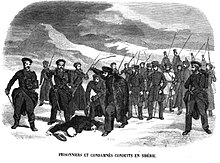驅逐出境
驅逐出境係將一個人或者一班人,由一個地方被迫去另一個地方嘅指令,通常都會造成強制遷徙。
國外驅逐
[編輯]
所有國家都有權驅逐冇居留權嘅人。一般嚟講,一啲犯咗嚴重罪行、非法入境、或者逗留超過簽證限期嘅外國人,都會俾人驅逐處境[1]。喺有啲情況下,就算一個國家嘅公民都有機會俾政府驅逐,例如波斯灣嘅國家驅逐自己嘅公民出境,跟住俾錢科摩羅去接收佢哋成爲公民[2][3]。
早喺18世紀發展嘅自然法,哲學家已經同意,一個國家由佢嘅歷史土地俾人驅逐係唔可以接受嘅[4]。喺20世紀尾,聯合國起草關於反人類罪嘅條文《Draft Code of Crimes Against the Peace and Security of Mankind》,其中第18章包括“大型同埋冇原因嘅驅逐出境係屬於反人類罪”[5]。
驅逐出境同拒絕入境唔同,因爲拒絕入境嘅人,係法律上從來冇踏足過國内,而驅逐出境嘅人,原本係合法咁喺國家入面住[6][7]。
國内驅逐
[編輯]
除咗驅逐去另外一個國家之外,亦可能喺一個國家入面驅逐。例如,喺美國內戰期間,喬治亞州驅逐咗400位女工廠工人,因爲懷疑佢哋係親北方[8]。喺18世紀期間,邁索爾王國嘅蘇丹驅逐咗幾萬位平民,嚟喺帝國其他地方做奴隸[9]。
喺二次大戰期間,史太林驅逐咗蘇聯國内嘅少數族裔,包括德意志人、車臣人、克里米亞韃靼人、烏克蘭人等等,大部分都係去西伯利亞嘅古拉格。歷史學家估計喺驅逐期間過世嘅有大約三分之一[10][11]。喺蘇聯嘅70幾年歷史期間,估計有大約600萬人俾政府驅逐[12][13],其中有150萬人喺期間過世[14][15]。
2004年2月26號,歐盟議會正式承認蘇聯驅逐車臣人為種族滅絕[16]。
喺同一時間,美國都出現咗唔少嘅國内驅逐。喺二次大戰期間,美國政府驅逐咗超過10萬位日本人、1.2萬位德國人、同埋3,000位意大利人[17]。
睇埋
[編輯]攷
[編輯]- ↑ Henckaerts, Mass Expulsion in Modern International Law and Practice, 1995, p. 5; Forsythe and Lawson, Encyclopedia of Human Rights, 1996, pp. 53–54.
- ↑ Mahdavi, Pardis (2016-06-30). "Stateless and for Sale in the Gulf". Foreign Affairs (美國英文). ISSN 0015-7120. 喺2024-01-03搵到.
- ↑ "To silence dissidents, Gulf states are revoking their citizenship". The Economist. 26 November 2016.
- ↑ See, e.g., Emerich de Vattel, The Law of Nations - Principles of the Law of Nature, Applied to the Conduct and Affairs of Nations and Sovereigns (translated from French), Philadelphia 1856 (Dublin 1792), Book II, § 90.
- ↑ International Law Commission, Yearbook of the International Law Commission 1996: Report of the Commission to the General Assembly on the Work of Its 48th Session, 2000.
- ↑ Fragomen and Bell, Immigration Fundamentals: A Guide to Law and Practice. New York: Practising Law Institute, 1996.
- ↑ "Deportations, Removals and Voluntary Departures from the UK - Migration Observatory".
- ↑ Dillman, The Roswell Mills and A Civil War Tragedy: Excerpts from Days Gone by in Alpharetta and Roswell, Georgia, 1996; Hitt, Charged with Treason: The Ordeal of 400 Mill Workers During Military Operations in Roswell, Georgia, 1864–1865, 1992.
- ↑ Farias, Kranti K. (1999). The Christian Impact in South Kanara (英文). Church History Association of India. p. 68. ISBN 978-81-7525-126-7.
- ↑ In one estimate, based on a report by Lavrenti Beria to Joseph Stalin, 150,000 of 478,479 deported Ingush and Chechen people (or 31.3 percent) died within the first four years of the resettlement. See: Kleveman, Lutz. The New Great Game: Blood and Oil in Central Asia. Jackson, Tenn.: Atlantic Monthly Press, 2003. ISBN 0-87113-906-5. Another scholar puts the number of deaths at 22.7 percent: Extrapolating from NKVD records, 113,000 Ingush and Chechens died (3,000 before deportation, 10,000 during deportation, and 100,000 after resettlement) in the first three years of the resettlement out of 496,460 total deportees. See: Naimark, Norman M. Fires of Hatred: Ethnic Cleansing in Twentieth-Century Europe. Cambridge, Massachusetts: Harvard University Press, 2001. ISBN 0-674-00994-0. A third source says a quarter of the 650,000 deported Chechens, Ingush, Karachais and Kalmyks died within four years of resettlement. See: Mawdsley, Evan. The Stalin Years: The Soviet Union 1929–1953. Manchester, England: Manchester University Press, 2003. ISBN 0-7190-6377-9. However, estimates of the number of deportees sometimes varies widely. Two scholars estimated the number of Chechen and Ingush deportees at 700,000, which would halve the percentage estimates of deaths. See: Fischer, Ruth and Leggett, John C. Stalin and German Communism: A Study in the Origins of the State Party. Edison, N.J.: Transaction Publishers, 2006. ISBN 0-87855-822-5
- ↑ Conquest, Robert. The Nation Killers. New York: Macmillan, 1970. ISBN 0-333-10575-3
- ↑ Pavel Polian (January 2004). Against Their Will: The History and Geography of Forced Migrations in the USSR. Central European University Press, 2004. p. 4. ISBN 978-963-9241-68-8.
- ↑ Rosefielde, Steven (2009). Red Holocaust. Routledge. p. 83. ISBN 978-0-415-77757-5.
- ↑ Naimark, Norman M. Stalin's Genocides (Human Rights and Crimes against Humanity). Princeton University Press, 2010. p. 131. ISBN 0-691-14784-1
- ↑ Rosefielde, Steven (2009). Red Holocaust. Routledge. p. 84. ISBN 978-0-415-77757-5.
- ↑ Campana, Aurélie. "Case Study: The Massive Deportation of the Chechen People: How and why Chechens were Deported", Online Encyclopedia of Mass Violence. November 2007. Accessed August 11, 2008; Nurbiyev, Aslan. "Relocation of Chechen 'Genocide' Memorial Opens Wounds". Agence France Press. June 4, 2008 互聯網檔案館嘅歸檔,歸檔日期December 2, 2008,.; Jaimoukha, Amjad M. The Chechens: A Handbook. Florence, Ky.: Routledge, 2005. ISBN 0-415-32328-2.
- ↑ Smith, Cary Stacy; Hung, Li-Ching (2010). The Patriot Act: Issues and Controversies. Springfield, Ill.: C.C. Thomas Publisher. pp. 84, 114, 124. ISBN 9780398079123.
